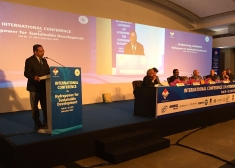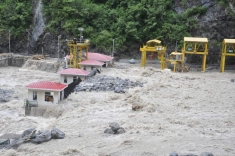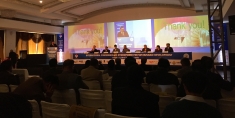Hydropower Sector Eyeing a Revival in India
Disclaimer: This is a minority report from the “International Conference on Hydropower for Sustainable Development”, which I attended the first week of February at Dehradun, India. The title was a bit of an oxymoron; a more suitable one would have been: “International Conference for Sustainable Development of the Hydropower Sector”. The suits in the room, executives working for the hydropower sector, have been fuming since the Supreme Court of India issued a moratorium on dam building in the state of Uttarakhand in the aftermath of the 2013 floods. Their ensuing frustration, and that of the state government, was palpable at the opening session of the conference.

At the outset, it was apparent to that the government-supported conference was a flex of muscle by industry, timed to shift the media focus from the social and ecological impact of large dams – which exacerbated the 2013 floods that killed more than 10,000 people – to instead justify hydropower at any cost under the guise of the country’s demand for energy. Even the apex court appears to have been persuaded while hearing the case on the 2013 floods by shrewd, selective rejoinders filed by government agencies. Read more details about the court hearing in a media report, here.
Participants at the conference included around 200 delegates from various government agencies as well as hydropower enterprises. I could count on my fingers the NGO and civil society representatives present; dissenting voices were conspicuously absent. We, the representatives of Indian NGOs, were among the select few “industry outsiders” who had obtained prior permission to attend.
The opening session set the tone for the three-day affair. Although the Chief Minister of Uttarakhand cancelled at the last moment, top bureaucrats and organizers took to the stage. Almost every panelist alluded to this being the dullest period of hydropower development, and how together they must find ways to revive the sector. At the top of the agenda was the call to change the perception of hydropower projects from financially risky projects with disastrous ecological and social impacts, to an important solution in meeting India’s energy demand. Officials, alluding to unspecified studies, concluded that hydropower dams were not in any way responsible for exacerbating the flood disaster of 2013. Even the advisor to the Chief Minister, U K Pawar, said that the perceived impacts of hydropower were not only unreasonable, but absurd. Everyone seemed to have expediently forgotten the report and findings of the Supreme Court committee, which affirmed the impact of dams in exacerbating the impact of the 2013 floods. Read a detailed blog on the report, here.
In the published recommendations of the 3-day conference, the general consensus is for “speedy development of hydropower for long-term energy security, water security, financial security and sustainable development”. The conference organizers determined that it should be left to all state government to decide whether or not to go ahead with hydropower projects. The people, their consent and participation, and statutory rights find no mention in the recommendations.
Earlier this month, the Union Minister for Power said that hydro projects were facing hurdles due to long delays and stoppage of works. To deal with judicial proceedings, Industry members have now urged that the state government defend all legal cases “against those who create obstructions for hydropower development…” and that the perception that hydropower exacerbated the disaster “…is removed as no study has brought out any fact or figure to support such misperception”. The conference proceedings again make no mention of the Supreme Court Expert Committee findings, which asserted just the opposite.
The Chief Minister, Harish Rawat, who did not attend the conference, sent a note in the attempt to lend credence to the conference’s seemingly premeditated findings and predictable recommendations. His note read: “The heavy rain and cloud burst triggered flash floods and landslides, which led to the disaster. Natural calamities happen since time immemorial. But people have associated this calamity immensely to the development of hydropower projects. Attributing hydropower development for such loss are more or less a result of lack of awareness and understanding of natural and manmade phenomena and some based on belief and not on scientific reasoning”. Again, by saying so the Minister has completely undermined the findings of the Supreme Court appointed expert committee.
Hydropower proponents are hopeful for a turnaround in their fortunes. Undoubtedly the tide is turning and the sector, with the help of the state government is going all out in their efforts to sweep the damning evidence from the 2013 floods under the carpet. The power developers have slammed the opinion that dams aggravated the flood fury, plainly referring to the Uttarakhand tragedy as a “hydro-meteorological” disaster.
The Union Ministry of Environment and Forests, which previously called for cumulative impact assessments, of late seems to have softened its stance. According to media reports, a meeting called by the Prime Minister’s office in January led the Ministry to focus on the legality of the appraisal and clearance of hydropower projects, and the difficulty faced by developers citing the growing need for energy, instead of the impact of such projects. It is now expected that some projects, to begin with, will be given the go-ahead by the Supreme Court.
The conference proved my growing fear - in the name of development at all costs, the proponents of hydropower in India are window dressing, once again, the image of the sector. And it seems to be working.




